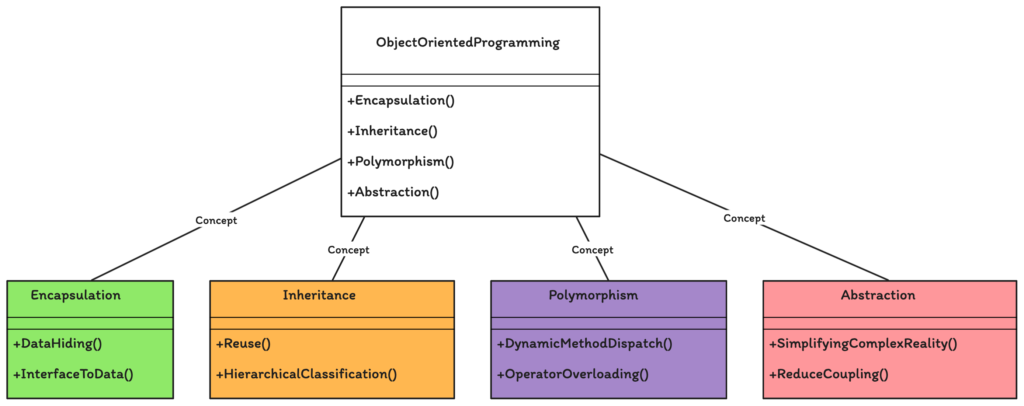Object-oriented programming (OOP) is a programming paradigm that has revolutionized the way software is developed. In this blog post, we will explore the history of OOP and discuss why it is essential for developers to learn this powerful programming approach.
The Origins of Object Oriented Programming
OOP traces its roots back to the 1960s when computer scientists began to explore new ways of organizing and structuring code. The concept of objects, which encapsulate data and behavior, was introduced to improve software development processes.
One of the earliest programming languages that embraced OOP principles was Simula, developed in the 1960s by Ole-Johan Dahl and Kristen Nygaard. Simula introduced the concept of classes and objects, laying the foundation for modern OOP languages.
The Rise of Object Oriented Programming
In the 1980s, OOP gained widespread popularity with the release of languages like C++ and Smalltalk. C++ combined the features of the C programming language with OOP concepts, making it a versatile and powerful language for software development. Smalltalk, on the other hand, was a pure object-oriented language that heavily influenced the design of subsequent OOP languages.
With the advent of Java in the mid-1990s, OOP became even more prevalent. Java’s platform independence and robustness made it a popular choice for developing enterprise-level applications. Today, OOP is a fundamental concept in many programming languages, including Python, Ruby, and C#.
Object-Oriented Programming (OOP) is a programming paradigm that organizes software design around objects, which can be thought of as instances of classes. In OOP, objects are created from classes, which define the properties and behaviors of the objects. OOP allows for the encapsulation of data and methods into objects, making it easier to manage and manipulate complex systems.
The history of OOP can be traced back to the 1960s, with the development of the Simula programming language. Simula introduced the concept of classes and objects, which laid the foundation for modern OOP languages. In the 1970s, Smalltalk was developed, which further popularized the use of OOP. Since then, many programming languages have adopted OOP principles, including Java, C++, and Python.
OOP is important in modern software development because it provides a way to organize and structure code in a more modular and reusable manner. By encapsulating data and methods into objects, OOP allows for code reuse, maintainability, and scalability. It also promotes code flexibility and modularity, making it easier to add new features or modify existing ones without affecting other parts of the codebase.
Key Takeaways
-
Object-Oriented Programming (OOP) is a programming paradigm that focuses on objects and their interactions.
-
The principles of OOP include encapsulation, inheritance, and polymorphism, which help to organize code and make it more reusable and maintainable.
-
OOP offers benefits such as modularity, scalability, and flexibility, making it a popular choice for modern development.
-
Encapsulation and abstraction are key concepts in OOP that help to hide implementation details and simplify code.
-
Inheritance and polymorphism allow for code reuse and flexibility, making it easier to create complex systems.
Understanding the Principles of OOP

There are four main principles of OOP: encapsulation, abstraction, inheritance, and polymorphism.
Encapsulation is the process of hiding internal details and providing a public interface for interacting with an object. It allows for data hiding, which means that the internal state of an object cannot be accessed directly from outside the object. Instead, external code can only interact with the object through its public methods. This helps to ensure data integrity and prevents unauthorized access or modification of an object’s internal state.
Abstraction is the process of simplifying complex systems by breaking them down into smaller, more manageable parts. It allows for the creation of abstract classes and interfaces, which define the common properties and behaviors of a group of objects. Abstraction helps to reduce complexity and improve code maintainability by providing a high-level view of the system, without exposing the internal details of how it works.
Inheritance is the process of creating new classes based on existing classes. It allows for the reuse of code and promotes code extensibility. Inheritance allows a new class to inherit the properties and behaviors of an existing class, while also allowing for the addition or modification of those properties and behaviors. This helps to reduce code duplication and makes it easier to manage and maintain large codebases.
Polymorphism is the ability of an object to take on many forms. It allows for the use of a single interface to represent different types of objects. Polymorphism is achieved through method overriding and method overloading. Method overriding allows a subclass to provide a different implementation of a method that is already defined in its superclass. Method overloading allows multiple methods with the same name but different parameters to be defined in a class. Polymorphism helps to improve code flexibility and allows for more dynamic and adaptable systems.
Benefits of OOP in Modern Development
OOP provides several benefits in modern software development:
1. Code reusability: OOP allows for the creation of reusable code components, which can be used in different parts of an application or even in different applications altogether. This reduces code duplication and makes it easier to maintain and update code.
2. Maintainability: OOP promotes code modularity, which makes it easier to understand, update, and debug code. Changes made to one part of the codebase are less likely to affect other parts, reducing the risk of introducing bugs or breaking existing functionality.
3. Scalability: OOP allows for the creation of scalable systems by breaking them down into smaller, more manageable objects. This makes it easier to add new features or modify existing ones without affecting the entire system.
4. Flexibility: OOP provides a flexible and adaptable approach to software development. The use of interfaces and polymorphism allows for the creation of code that can work with different types of objects, making it easier to extend or modify the system as requirements change.
5. Modularity: OOP promotes code modularity, which makes it easier to organize and manage large codebases. By breaking down a system into smaller, self-contained objects, it becomes easier to understand, test, and maintain the code.
How OOP Enhances Code Reusability and Maintainability
| Benefits of OOP | Description |
|---|---|
| Code Reusability | OOP allows developers to create reusable code components, called classes, that can be used in multiple parts of an application. This reduces the amount of code that needs to be written and makes it easier to maintain. |
| Maintainability | OOP promotes the use of encapsulation, inheritance, and polymorphism, which make it easier to modify and maintain code. Encapsulation ensures that data is protected and only accessible through defined methods, inheritance allows for the creation of new classes based on existing ones, and polymorphism allows for the use of a single interface to represent multiple classes. |
| Modularity | OOP encourages the creation of modular code, which is easier to understand and maintain. Classes can be designed to perform specific tasks, and can be combined to create more complex functionality. |
| Scalability | OOP allows for the creation of scalable applications, as new functionality can be added by creating new classes that build on existing ones. This makes it easier to add new features and expand the application over time. |
OOP achieves code reusability and maintainability through the use of encapsulation, inheritance, and polymorphism.
Encapsulation allows for the hiding of internal details and provides a public interface for interacting with an object. This helps to ensure data integrity and prevents unauthorized access or modification of an object’s internal state. By encapsulating data and methods into objects, code can be reused in different parts of an application or even in different applications altogether. This reduces code duplication and makes it easier to maintain and update code.
Inheritance allows for the creation of new classes based on existing classes. This promotes code reusability by allowing a new class to inherit the properties and behaviors of an existing class. This reduces code duplication and makes it easier to manage and maintain large codebases. Inheritance also allows for code extensibility, as new classes can add or modify the properties and behaviors inherited from their superclass.
Polymorphism allows for the use of a single interface to represent different types of objects. This improves code flexibility by allowing objects to be treated as instances of their superclass or interface, rather than their specific type. This makes it easier to write code that can work with different types of objects, without having to know their specific implementation details. Polymorphism also allows for more dynamic and adaptable systems, as objects can be easily replaced or extended without affecting the rest of the codebase.
Encapsulation and Abstraction in OOP
Encapsulation and abstraction are two important principles of OOP that help to improve code maintainability and reduce complexity.
Encapsulation is the process of hiding internal details and providing a public interface for interacting with an object. It allows for data hiding, which means that the internal state of an object cannot be accessed directly from outside the object. Instead, external code can only interact with the object through its public methods. This helps to ensure data integrity and prevents unauthorized access or modification of an object’s internal state.
For example, consider a class that represents a bank account. The internal state of the account, such as the account balance, should not be accessible directly from outside the class. Instead, the class can provide public methods, such as deposit() and withdraw(), which allow external code to interact with the account. This encapsulation of data and methods into objects makes it easier to manage and manipulate complex systems.
Abstraction is the process of simplifying complex systems by breaking them down into smaller, more manageable parts. It allows for the creation of abstract classes and interfaces, which define the common properties and behaviors of a group of objects. Abstraction helps to reduce complexity and improve code maintainability by providing a high-level view of the system, without exposing the internal details of how it works.
For example, consider a car rental system. The system may have different types of vehicles, such as cars, trucks, and motorcycles. Each type of vehicle may have different properties and behaviors, such as the number of seats or the maximum speed. By creating an abstract class or interface called Vehicle, we can define common properties and behaviors that all vehicles share. This abstraction allows us to treat all vehicles as instances of the Vehicle class or interface, without having to know their specific implementation details.
Inheritance and Polymorphism in OOP

OBJECT ORIENTED PROGRAMMING
Inheritance and polymorphism are two important principles of OOP that help to improve code reusability and flexibility.
Inheritance is the process of creating new classes based on existing classes. It allows for the reuse of code and promotes code extensibility. Inheritance allows a new class to inherit the properties and behaviors of an existing class, while also allowing for the addition or modification of those properties and behaviors. This helps to reduce code duplication and makes it easier to manage and maintain large codebases.
For example, consider a class hierarchy for different types of vehicles. We can have a base class called Vehicle, which defines common properties and behaviors that all vehicles share, such as the number of wheels or the maximum speed. We can then create subclasses for specific types of vehicles, such as Car, Truck, and Motorcycle. These subclasses can inherit the properties and behaviors defined in the Vehicle class, while also adding or modifying them as needed.
Polymorphism is the ability of an object to take on many forms. It allows for the use of a single interface to represent different types of objects. Polymorphism is achieved through method overriding and method overloading. Method overriding allows a subclass to provide a different implementation of a method that is already defined in its superclass. Method overloading allows multiple methods with the same name but different parameters to be defined in a class. Polymorphism helps to improve code flexibility and allows for more dynamic and adaptable systems.
For example, consider a class hierarchy for different types of animals. We can have a base class called Animal, which defines common properties and behaviors that all animals share, such as the ability to eat or sleep. We can then create subclasses for specific types of animals, such as Dog, Cat, and Bird. Each subclass can provide its own implementation of the eat() method, which is defined in the Animal class. This allows us to treat all animals as instances of the Animal class, without having to know their specific type.
OOP Design Patterns and Best Practices
-
Design patterns are reusable solutions to common problems that occur in software design. They provide a way to solve recurring design problems in a consistent and efficient manner. There are many design patterns that can be used in OOP, such as the Singleton pattern, Factory pattern, and Observer pattern.The Singleton pattern is used when we want to ensure that only one instance of a class is created. This can be useful in situations where we need to limit the number of instances of a class, such as when creating a database connection or a logger. The Singleton pattern provides a global point of access to the instance of the class, ensuring that only one instance is created and shared across the application.
-
The Factory pattern is used when we want to create objects without specifying their exact class. This can be useful when we have a hierarchy of classes and we want to create objects based on their common interface or abstract class. The Factory pattern provides a way to encapsulate the object creation logic in a separate class, making it easier to manage and maintain.
-
The Observer pattern is used when we want to establish a one-to-many relationship between objects, where one object (the subject) notifies other objects (the observers) of any changes in its state. This can be useful in situations where we need to decouple the subject from its observers, allowing for more flexible and extensible systems.
-
In addition to design patterns, there are also several best practices for OOP programming:
-
Use meaningful and descriptive names for classes, methods, and variables.
-
Follow the Single Responsibility Principle (SRP), which states that a class should have only one reason to change.
-
Use proper encapsulation to hide internal details and provide a public interface for interacting with an object.
-
Avoid code duplication by using inheritance and code reuse.
-
Write clean and readable code by following coding conventions and using proper indentation and formatting.
-
Use comments and documentation to explain the purpose and functionality of your code.
-
Test your code thoroughly to ensure that it works as expected and handles all possible edge cases.
OOP in Popular Programming Languages
OOP is widely used in many popular programming languages, including Java, Python, and C++. Each language has its own syntax and features for implementing OOP principles.
Java is a popular programming language that was designed with OOP principles in mind. It has built-in support for classes, objects, inheritance, and polymorphism. Java uses the class keyword to define classes and the new keyword to create objects. It also supports access modifiers, such as public and private, to control the visibility of class members.
Python is another popular programming language that supports OOP. It has a more flexible syntax compared to Java, allowing for more concise and expressive code. Python uses the class keyword to define classes and the self parameter to refer to the current instance of a class. It also supports multiple inheritance, which allows a class to inherit from multiple parent classes.
C++ is a powerful programming language that supports both procedural and object-oriented programming. It has built-in support for classes, objects, inheritance, polymorphism, and encapsulation. C++ uses the class keyword to define classes and the new keyword to create objects. It also supports access specifiers, such as public, private, and protected, to control the visibility of class members.
While each programming language has its own syntax and features for implementing OOP principles, the underlying concepts remain the same. Understanding these concepts is key to becoming proficient in any OOP language.
How OOP is Used in Web Development
OOP is widely used in web development to build scalable and maintainable web applications. It provides a way to organize code into reusable and modular components, making it easier to manage and update.
Web development frameworks, such as Ruby on Rails and Django, are built on top of OOP principles. These frameworks provide a set of tools and conventions for building web applications, while also promoting code reusability and maintainability.
Ruby on Rails is a popular web development framework that is built on top of the Ruby programming language. It follows the Model-View-Controller (MVC) architectural pattern, which separates the application logic into three main components: the model, the view, and the controller. The model represents the data and business logic of the application, the view represents the user interface, and the controller handles user requests and updates the model and view accordingly. Ruby on Rails uses OOP principles to define models, views, and controllers as classes, allowing for code reuse and modularity.
Django is a web development framework that is built on top of the Python programming language. It also follows the MVC architectural pattern, with models, views, and controllers implemented as classes. Django uses OOP principles to define models that represent database tables, views that handle user requests, and controllers that update the model and view accordingly. Django also provides a powerful Object-Relational Mapping (ORM) system, which allows developers to interact with the database using Python objects instead of writing raw SQL queries.
By using OOP principles in web development, developers can build scalable and maintainable web applications that are easier to manage and update. OOP allows for code reusability, maintainability, scalability, flexibility , and modularity. With OOP, developers can create classes and objects that encapsulate data and behavior, making it easier to organize and manage code. Inheritance allows for the creation of hierarchies, where classes can inherit properties and methods from parent classes, reducing code duplication. Polymorphism enables the use of different objects interchangeably, increasing flexibility and extensibility. Additionally, OOP promotes separation of concerns, allowing developers to focus on specific modules or components of the application without affecting others. Overall, OOP principles enhance the development process by providing a structured and efficient approach to building web applications.
Why you should learn OOP
Realizing that OOP is a standard in the industry and a cornerstone of many modern technologies and frameworks has motivated me to master it. This knowledge not only opens up a plethora of career opportunities but also ensures that I can engage effectively with a wide range of software development projects.
Ajay – SAGYE Developer
FAQs
What is object-oriented programming?
Object-oriented programming (OOP) is a programming paradigm that focuses on the use of objects to represent and manipulate data. It is based on the concept of classes and objects, where a class is a blueprint for creating objects, and an object is an instance of a class.
What are the benefits of object-oriented programming?
Object-oriented programming offers several benefits, including code reusability, modularity, and maintainability. It allows developers to create complex applications by breaking them down into smaller, more manageable components. OOP also promotes better organization of code, making it easier to understand and modify.
What are the key features of object-oriented programming?
The key features of object-oriented programming include encapsulation, inheritance, and polymorphism. Encapsulation refers to the practice of hiding the internal details of an object from the outside world. Inheritance allows classes to inherit properties and methods from other classes. Polymorphism allows objects to take on multiple forms, depending on the context in which they are used.
What programming languages support object-oriented programming?
Many programming languages support object-oriented programming, including Java, C++, Python, Ruby, and PHP. These languages provide built-in support for classes, objects, and other OOP concepts.
Why do I need to learn object-oriented programming?
Object-oriented programming is a widely used programming paradigm that is essential for developing complex applications. It is used in a variety of industries, including software development, web development, and game development. Learning OOP will help you become a better programmer and increase your job prospects in the tech industry.


